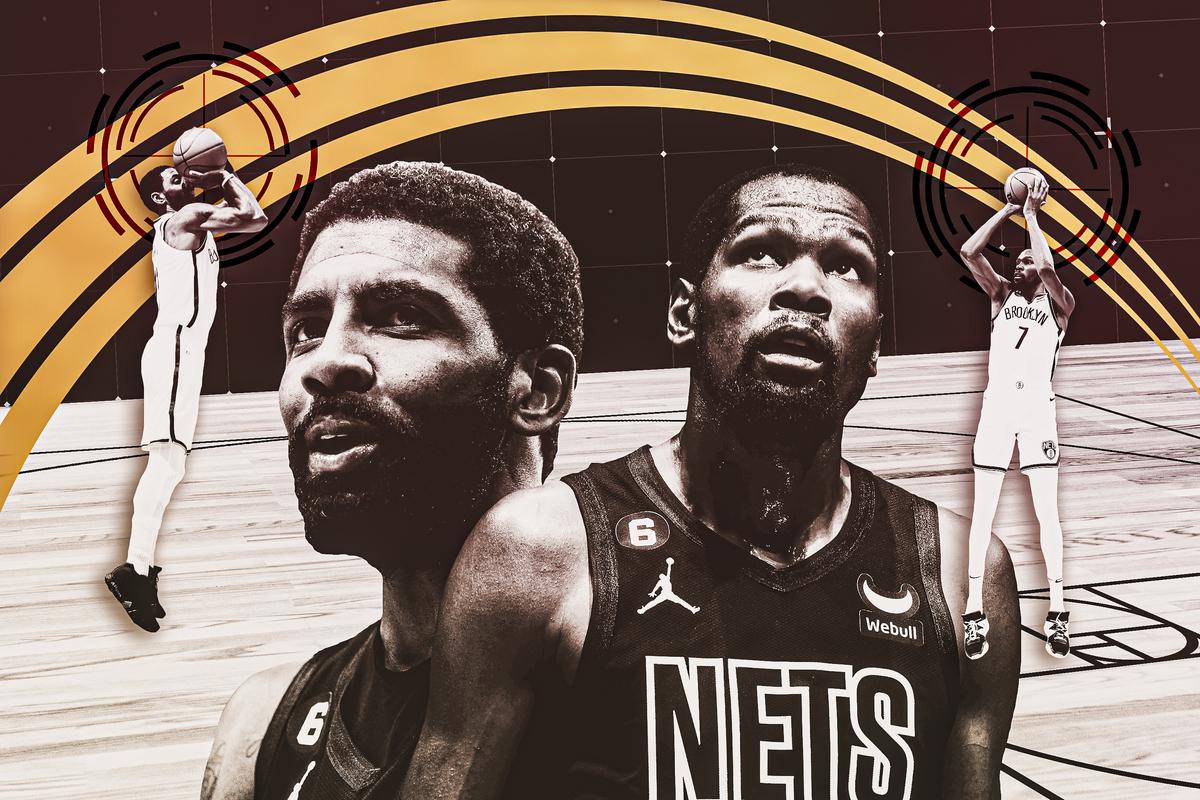
If not for the unsettling behavior that plagued Barclays Center earlier this season—not to mention the months of dysfunction, trade demands, and chaos that preceded it—these Brooklyn Nets would be revered. On paper, Brooklyn might have the greatest collection of shooters ever assembled. In reality, that’s exactly what it has been.
The Nets are the NBA’s hottest team. They’ve lost one game in the last four weeks and became a blowtorch in December, sporting an NBA-best 120.5 offensive rating. But even all of that doesn’t begin to describe how impressive their season has become. This team is historically great at the one thing every team wishes it could be historically great at; the best possible version of what the front office conceptualized during an offseason that otherwise sapped so much optimism from what was possible.
Brooklyn currently ranks first all time in effective field goal percentage and true shooting percentage, second in 2-point field goal percentage, and is tied for 18th in 3-point percentage. We’re not even at the All-Star break, sure. But Brooklyn’s current effective field goal percentage is slightly ahead of where the 2018 Warriors—which once had the highest effective field goal percentage on record—were at the 40-game mark.
Kevin Durant and Kyrie Irving are peerless, unguardable marksmen who regularly drain fanciful shots that most NBA players can’t even conjure in a daydream. Durant—who left Sunday night’s game early with a knee injury and will get an MRI on Monday—is currently experiencing the most efficient season of his Hall of Fame career and averaging 30 points per game, while Irving has crossed the hallowed 50/40/90 barrier since returning from his eight-game suspension in late November.
But Brooklyn’s shooting success goes far beyond Irving and Durant. Seth Curry and Joe Harris are the third- and fourth-most accurate 3-point shooters in NBA history (minimum 1,000 attempts). Yuta Watanabe is a blazing 52.7 percent behind the arc. Royce O’Neale and T.J. Warren can’t be ignored 25 feet from the basket. Patty Mills isn’t even in the rotation but is a career 39 percent 3-point shooter.
In the paint, Brooklyn also has Nic Claxton, who leads the league in field-goal percentage and does a terrific job capitalizing off all the attention everyone else demands. Ben Simmons is predictably reluctant to shoot unless the seas part, but deserves plenty of credit for accelerating this team’s tempo and diming up those aforementioned weapons in transition.
All together, head coach Jacque Vaughn’s simplified offensive system has become a nirvana of gravity and space that induces complete and total panic for the opposition. There are several reasons to believe this group can win the title—their top-five defense since November 1 shouldn’t be overlooked—but Brooklyn’s ability to absolutely drown opponents with sensational, sustainable outside shooting is why nobody wants to see them in the playoffs.
It sounds reductive to explain their turnaround from a 2-6 start this way, but sometimes basketball is a simple game; when a team makes a lot of shots, regardless of their degree of difficulty or where they’re launched on the floor, wounds heal, flaws are glossed over, and lots of games are won.
The Nets have one of the best offenses in the league despite ranking 27th in offensive rebounding rate and 26th in free-throw rate. Instead, they triumph with jumpers that originate from spots on the court most of the league purposefully shuns.
The Nets rank 29th in location effective field goal percentage, meaning Daryl Morey requires an EpiPen whenever he glances at their shot profile. Despite a diet of field-goal attempts that don’t typically lead to an efficient offense, Brooklyn ranks first in quantified shooter impact (qSI) by a mile, with an effective field goal percentage that’s 7.8 percent above what teams with average shooters would squeeze from the same shots their players take. The difference between the Nets and the second-place Nuggets is as wide as the difference between the Nuggets and the 18th-place Pelicans.
Only two teams average more midrange attempts per game than the Nets, and none even come close to Brooklyn’s 51.2 percent accuracy. A lot of that is because of Durant, who’s shooting an inconceivable 57.1 percent from midrange and has made more shots from that zone than 13 teams this season.
Since at least the 1996-97 season, no player who’s jacked up at least 300 2-point jump shots 10 or more feet from the basket has been more accurate than Durant is right now. And the Nets are also the first team ever in Second Spectrum’s database to average more than 0.97 points per midrange shot. They’re currently at 1.09.
All of these looks going in as often as they do are why the clouds have parted at the corner of Flatbush and Atlantic Avenue. The Nets are loaded with midrange conservationists (Durant, Irving, Warren, Curry, etc.) but coached by a strategist who is not ignorant of the virtues of spacing. Yes, they’re 24th in 3-point rate and 25th in catch-and-shoot 3s per game. But they also rank second in 3-point accuracy while utilizing lineups that engender so many pick-your-poison conundrums.
With a banged-up roster that’s started eight different lineups, Vaughn has had to tinker and experiment with different five-man combinations. When everyone is together, he’s been able to stay big and long on the wings without sacrificing any of what makes the Nets’ offense so lethal.
And even when they have two non-shooters on the floor at the same time, Brooklyn’s star power can take over one-on-one, drawing double-teams, making simple reads, and kindling open looks. They’re still wrecking balls in isolation, too. No team is more efficient on these plays, and only four isolate more frequently. Durant is immortal here. Irving lives on an astral plane.
Brooklyn’s regular starting five—Durant, Irving, O’Neale, Claxton, and Simmons—has, so far, functioned as a top-10 offense. And since Kyrie returned from his suspension, lineups featuring Simmons and Claxton have been volcanic, posting a 121.6 offensive rating in 258 minutes.
Some of that is because they don’t overly rely on pick-and-rolls. Not only do the Nets rank last in ball screens per game, but Luka Doncic by himself initiates more than Brooklyn’s entire team (51 to 49). Why go that route when so many other options are available, both random and scripted?
Yours truly could be the Nets starting point guard and it wouldn’t harm their ability to run KD off a pindown whenever they want. The action is basketball’s version of sliced bread. Reliable. Universally appreciated. Perfect. It’s also unstoppable. No player generates more than the 1.51 points per possession Durant does when a down screen leads to a shot:
Vaughn has also done a good job leveraging everyone’s strengths in the same set. There are several layers to the play below that make it so hard to stop, even for one of the league’s most stout defenses:
It begins with a bone-rattling screen by Simmons on Cleveland’s Lamar Stevens that forces Jarrett Allen to jump off Claxton and switch out on Durant. Allen is capable, but a red light flashes any time a center finds himself on an island against KD. It was a decoy, though. As every other Cavalier turns their attention toward the ball, Irving zips up and around a road block constructed by Simmons and Claxton that Darius Garland has no chance to avoid.
Irving and Durant are skeleton keys who can single-handedly obliterate base defenses in the most straightforward way. They draw two defenders, get off the ball, and good things happen. With Durant in particular, sometimes the help comes out of sheer desperation. It’s a break-in-case-of-emergency option before any danger even materializes (related: Brooklyn owns the NBA’s second best crunch-time offense and is an absurd 16-3 in those contests):
When teams have to avoid a switch and double the ball, Claxton knows how to make plays against a four-on-three advantage. It’s another reason he and Simmons, two non-shooters, are able to co-exist as well as they have.
The Nets’ shots aren’t a fluke. This team is loaded with some of the most accurate and dependable shooters basketball has ever known. And even if/when one or two of their best shooters finds himself in a slump, the level of respect they garner around the league means it won’t have any negative impact on Brooklyn’s gravity. Curry or Harris could miss 20 straight 3s and their defender still wouldn’t drift off them in the weakside corner.
That type of threat makes these Nets a juggernaut. A balanced, harmonious team that’s simultaneously antiquated and perfect for the modern game. They share the ball because they trust that pretty much every shot is a good one. And, so far, no defense has figured out a way to slow them down. Possibly because no solutions exist.

